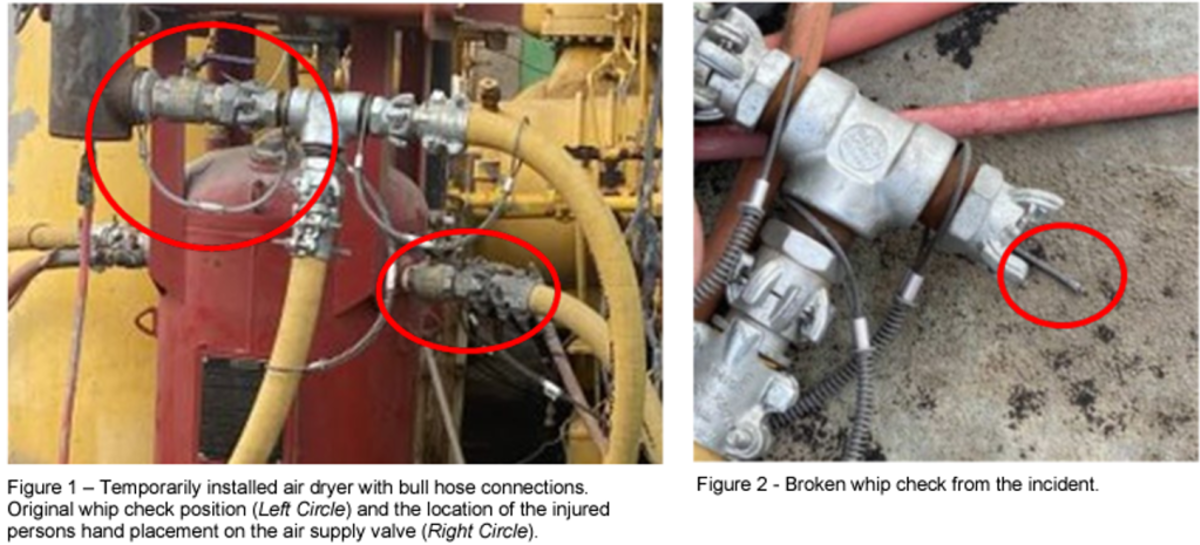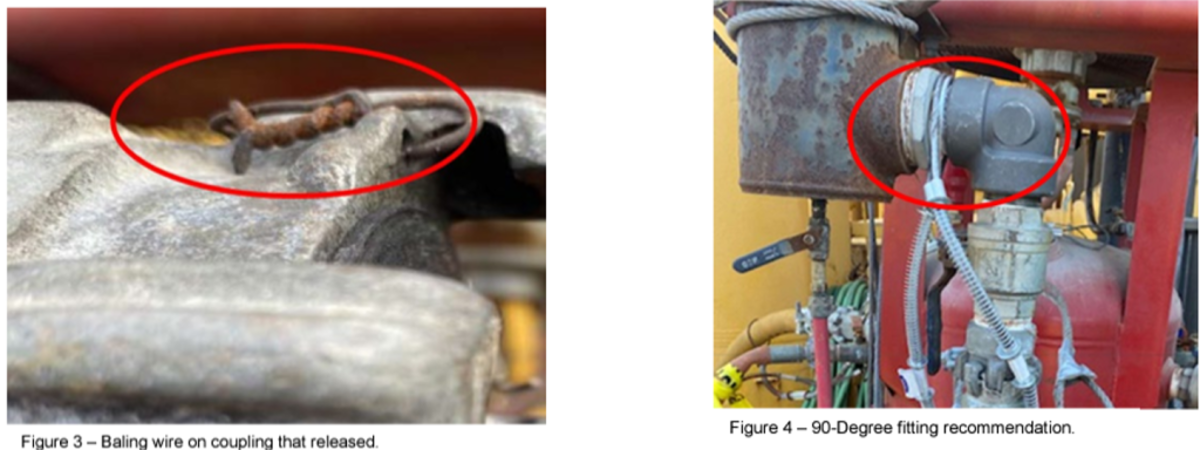BSEE: Person injured when safety mechanisms failed
- Safety Flash
- Published on 20 April 2023
- Generated on 20 November 2025
- IMCA SF 10/23
- 2 minute read
Jump to:
The United States Bureau of Safety and Environmental Enforcement (BSEE) has published Safety Alert 455 relating to an incident in which a third-party contract operator sandblasting offshore was injured when a temporary air dryer used for sandblasting operations recoiled and broke the safety cable.
What happened?
A broken whip check and T-connection hit the worker and caused multiple cuts and abrasions to his head and shoulders.
The worker was refilling the sand pot with an abrasive material to continue sandblasting operations. After confirming the air supply valve from the temporary air dryer to the sand pot was shut-in, the worker attempted to disconnect the air supply valve (Figure 1 – Right Circle) from the air dryer. As he tried to access this coupling, he loosened the T-connection. The T-connection blew off and broke the braided steel whip check or safety cable which hit the worker causing injury.

What went wrong?
-
BSEE inspectors identified the following contributing factors:
- The baling wire involved in the incident was slightly corroded, potentially diminishing its overall integrity. Baling wire is used as an additional safety measure to ensure couplings are securely connected. It is often used in place of a cotter pin on crowfoot couplings.
- The failed whip check cable was improperly crimped. Crimping the whip check cable before placing it into service allows it to function correctly at its full rated capacity.
- The bull hose configuration on the air inlet valve from the platform air compressor was installed in a horizontal position. This added weight caused the T-connection to be off-centre at the time of operation, adding stress on the associated couplings and baling wire. The added weight, combined with the worker’s force when manipulating the air supply valve to the sand pot, resulted in air escaping the inlet valve from the platform compressor, likely causing the connection to come loose.
- The baling wire involved in the incident was slightly corroded, potentially diminishing its overall integrity. Baling wire is used as an additional safety measure to ensure couplings are securely connected. It is often used in place of a cotter pin on crowfoot couplings.

Lessons learned
BSEE recommendations:
- Ensure all risks and associated mitigations of this kind of task are fully understood.
- Install stainless steel tie wires in addition to whip checks on bull hoses to reduce the risk of disconnection.
- Install 90-degree fittings (see illustration) to eliminate the horizontal orientation of the supply hose, reducing the stress at each connection.
- Where practical, depressurise equipment prior to adjusting valves.
- Inspect all equipment and parts pre-job to ensure they are in adequate condition.
Related safety flashes
-
IMCA SF 04/23
9 February 2023
-
IMCA SF 10/07
20 December 2007
IMCA Safety Flashes summarise key safety matters and incidents, allowing lessons to be more easily learnt for the benefit of the entire offshore industry.
The effectiveness of the IMCA Safety Flash system depends on the industry sharing information and so avoiding repeat incidents. Incidents are classified according to IOGP's Life Saving Rules.
All information is anonymised or sanitised, as appropriate, and warnings for graphic content included where possible.
IMCA makes every effort to ensure both the accuracy and reliability of the information shared, but is not be liable for any guidance and/or recommendation and/or statement herein contained.
The information contained in this document does not fulfil or replace any individual's or Member's legal, regulatory or other duties or obligations in respect of their operations. Individuals and Members remain solely responsible for the safe, lawful and proper conduct of their operations.
Share your safety incidents with IMCA online. Sign-up to receive Safety Flashes straight to your email.